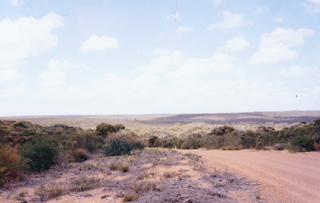I could not leave this series of posts without mentioning Kangaroo Island, which was extensively burnt in the Summer bush fires, as I watched in disbelief whilst more and more of the Island was impacted by fire. The cause of this, the Ravine Fire, was in beautiful Flinders Chase National Park, which we had visited in November 2004. This time the diary is taken from journalling in a scrapbook and the photos (taken with film: yes there was a time before digital!), had to be scanned from the scrapbook.
Something had been dropping on the roof of the van all night
(Gumnuts? Pinenuts?), and we had heard Koalas fighting (they appear to change
trees at night and must dispute trees). Apparently this in only one of two main
places to find Koalas on K.I. (they are not everywhere at all!!). John had a breakfast
companion with a kangaroo resting next to the van, and there was a Koala in a
tree near the van. (We were stating at Western K.I. Caravan Park and Wildlife Reserve).
Today we drove into Flinders Chase National Park and visited
Park headquarters first up for registration ($6.50) and maps. We then stopped
briefly at Bunker Hill Lookout on the way to Admiral’s Arch at Cape de Couedic
Lighthouse. We followed the long boardwalk and steps down to the Arch and New
Zealand Fur Seals. Two seals were having an altercation on the rocks.
Everything has French names this end of the Island (Baudin
must have gotten here before Flinders). We were back in limestone cliff country
(hence the Arch), but here was an abundance of wildflowers (some unique to this
Island). There were small islands off Cape de Couedic.
Weirs Cove (which we visited next) must have escaped
Baudin’s attention and been named later! It is a short drive from the
lighthouse and was the closest place to land lighthouse supplies (probably a
long way for a horse). The flying fox was used to bring people and horses as
well as goods up the cliff (and sandstone for the lighthouse). The Keepers lived
in cottages at the lighthouse, but other workers lived at Weirs Cove and the
ruins of the living quarters indicated that there was only one room per family.
Next stop was Remarkable Rocks (still on the tourist trail,
with an impressive board walk out to the rocks). There were warnings not to
venture too far from the ocean side (you could easily slide into the ocean).
I found out that it is a good idea to
check how much film is left in the camera before leaving the car – I had to
walk back to get some!
After this we travelled to West Bay Beach and, to get here
we followed an unsealed road through various types of Park vegetation and past
walking tracks to Rocky River and Breakneck River (both closed). West Bay Beach
was a beautiful secluded beach (which we had to ourselves until we left). We
first followed a cliff walk across treacherous limestone, and then walked along
the beach (our first beach walk this time!). The Loch Vennachar was wrecked off
this beach but not found for 70 years. The only inhabitant ever here was a
possum trapper, but there is also a grave of a shipwrecked sailor who walked
this far from further around the coast. When we got back to the car an Osprey
appeared and hovered over the beach (until another car arrived).
We had to travel nearly all the way back to the Visitor’s
Centre before reaching the beginning of the very corrugated Shackles Road,
which went north through the middle of the wilderness area. There were a number
of marked spots with explanations in a booklet we had been given. We travelled
through a range of vegetation and wildflowers until eventually joining the
Playford Highway near Cape Borda. It was too late to do the lighthouse tour,
which was at 2 p.m., so we decided to visit here tomorrow, although it meant a
long drive back. We could see a kangaroo hopping backwards and forwards across
the road in the distance, but when we reached it, “it” turned out to be two
mating.
Near the beginning of Shackles Road
we had taken a detour into Platypus Waterholes (Platypus are introduced species), and a short
track to the first observation point – here we saw plenty of bubbles and
action, but none would surface. We also stopped at Bullocks Waterhole, where
there were lots of wildflowers.































